Herring Home | Fishing for herring | Back to Development of Engine Power
Engine-powered Scottish fishing boats
Steam drifters
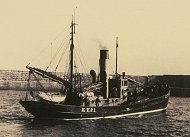
Steam drifters were large boats, usually 80-90 feet in length with a beam of around 20 feet. They weighed 40-50 tons and travelled at 9-11 knots. The first steam drifters were made of wood, but steel hulls were soon introduced. The steam drifters were divided into watertight compartments. They were well designed for the crew with a large building contained the wheelhouse and the deckhouse. They did not have sails, apart from a mizzen sail, which was used to help steady the boat when its nets were out. The main function of the mast was now as a crane for lifting the catch ashore. They also had a steam capstan on the foredeck near the mast for hauling nets. The steam drifters had thin, high funnels so that the steam was released high above the deck away from the fishermen. They were nicknamed woodbines because the tall funnels looked like the popular brand of cigarettes. These boats had a crew of twelve made up of a skipper, driver, fireman (to look after the boiler) and nine deck hands.
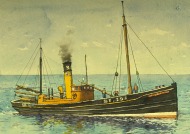
Steam drifters had many advantages. They were usually about 20ft longer than the sailing vessels so they could carry more nets and catch more fish. This was important because the market was growing quickly at the beginning of the 20th century. They could travel faster and further and with greater freedom from weather, wind and tide. Because less time was spent travelling to and from the fishing grounds, more time could be spent fishing. The steam drifters also gained the highest prices for their fish as they could return quickly to harbour with their very fresh catch.
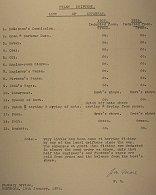
The main disadvantage of the steam drifters was the high costs. Their engines were also mechanically inefficient and took up much space. The steam drifters were expensive to fit out and running costs were very high as they used large quantities of coal. Before World War I building costs were between £3000 and £4000, at least three times the cost of the sailing drifters. To cover these high costs, the steam drifters needed to fish for longer seasons. The higher expenses meant that more steam drifters were company owned or jointly owned. As the herring fishing industry declined, steam drifters became too expensive.
Motor Vessels
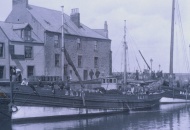
Petrol and paraffin engines began to be used in 1906. At first, they were mainly fitted to smaller boats of between 18 and 30 feet in length and they provided auxiliary power to assist the sails. However, as engines became more powerful the sails were replaced altogether and the engines were fitted in larger and larger boats. Motor engines were relatively cheap, making them affordable to individual fishermen. Early engines cost under £100 and fuel costs were low. These boats also needed less maintenance than steam vessels. The two most popular engine brands were the Gardiner and Kelvin engines.
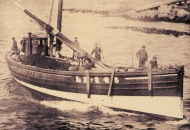
The compact engines meant they could be fitted to existing sailing drifters such as fifies and zulus. The traditional fifie style was better suited to the installation of a motor, which led to the custom building of a number of modified fifie design boats with motors.
Until the 1930s, motorboats were built the same shape as sailing boats with a straight stem and stern. However, from the 1930s, there were a number of changes in boat design. From the mid 1930s cruiser sterns were introduced with rounder sterns and bows. Wider sterns gave more space below for the engine and allowed the crew more space to work on deck. Square transom sterns were first used in the early 1960s, they gave more space above and below decks and so quickly became standard. Developments in hull design made life more comfortable for fishermen working aboard.
Herring Home | Fishing for herring | Back to Development of Engine Power